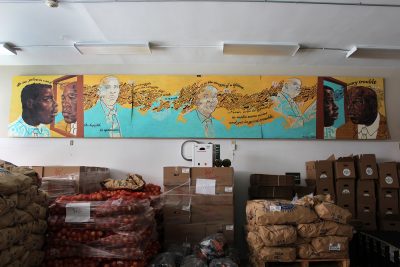A mural of civil rights icon John Lewis found a new, indoor home after being vandalized in November.

It hangs today at Food for Free’s volunteer packing center in East Cambridge, a nonprofit dedicated to redistributing food to under-served communities.
Marks of the vandalism were left intentionally during the mural’s restoration — countered with white paint strokes — said artist Rocky Cotard, who painted the mural last summer.
“For me as an artist, I thought it was important to remember that, when I looked at the piece, that there were some voices that challenged the inherent nature of what we were doing,” Cotard said.
Art conservators, volunteers and financial backers came to Cotard’s aid as he cleaned the piece in November. He said was “super amazed and moved” by the community’s support.
Erin Miller, executive chef and owner of farm-to-table restaurant Urban Hearth, commissioned Cotard to paint the mural for her outdoor dining area in August — following Lewis’ death the month prior.
Lewis’ message of hope was one that deeply resonated with Miller, she wrote in an open letter attached to the mural at Food for Free. She requested Cotard include a quote Lewis tweeted in 2018 in the mural.
“Do not get lost in a sea of despair,” the mural reads, echoing Lewis. “Be hopeful, be optimistic. Our struggle is not the struggle of a day, a week, a month, or a year, it is the struggle of a lifetime. Never, ever be afraid to make some noise and get in good trouble, necessary trouble.”
Lewis was one of the leaders of the civil rights movement in his youth. At 25, he led the 1965 march from Selma to Montgomery, Alabama that influenced the passing of the Voting Rights Act later that year.
Cotard painted seven portraits of Lewis at various stages in his life. At either end of the mural, Lewis looks at his old and young reflection in the mirror, and between them, his “watery” and “turbulent” experiences, Cotard said.
“The sense of his messages, the sense of his concepts, the way that he lived his life were all things that we, the living, will really meditate on and learn from,” Cotard said.
Cotard finished the three-piece mural for Urban Hearth in October — one month before it was tagged.
Black paint had crossed over the yellow and blue of the several portraits’ eyes, as well as segments of Lewis’ flowing quote.
The vandal has not been identified, but there is no evidence to suggest the painting was specifically targeted, Jeremy Warnick, director of communications and media relations at the Cambridge Police Department, wrote in an email.
Painting conservator Gianfranco Pocobene assisted in restoring the mural a week later. He said Urban Hearth and community members who had heard about the vandalism reached out to him for his help.
Pocobene said he, Cotard and assistant painting conservator Corrine Long cleaned off most of the spray paint in about 12 hours in a space at Lesley University College of Art and Design.
Miller added that Urban Hearth has featured artists’ works since its opening, and once outdoor dining opens again she will “definitely be considering how to fill the patio walls.”
“Everything we do at Urban Hearth is guided by our strong sense of community and awareness of the role a restaurant plays in creating a nurturing space for our patrons and the broader community,” Miller wrote in an email. “I am very excited that Food for Free is able to host the mural temporarily and we will revisit our partnership in June.”
Amanda Trombley, marketing manager at Food For Free, said she first heard about the mural as the restaurant closed its dining patio. At the time, Food for Free had just opened a volunteer packing center in East Cambridge, she said.
“I was looking for something that would inspire our volunteers as they were working to pack grocery boxes for three of our four programs,” Trombley said.
Trombley said the volunteers have loved the mural, and Lewis’ message of social justice is one that aligns with Food for Free’s values.
The mural is visible from Cambridgeside Galleria on the other side of the street, and Trombley said it’s not uncommon for people to look as they’re passing by.
Cotard said he was happy to see the mural hang at a place that gives back to the community, which mirrors the values of the urban arts community.
“When I got that image, I was moved and I was excited,” he said, “because it just represented so much of what we were hoping for.”


















































































































